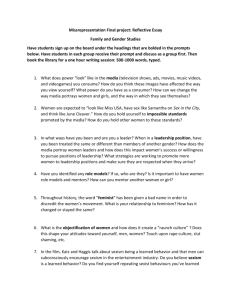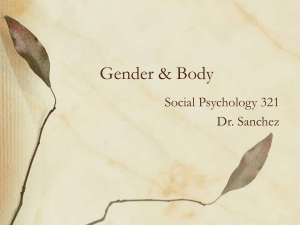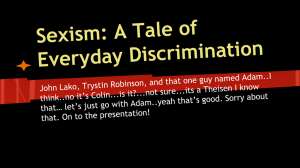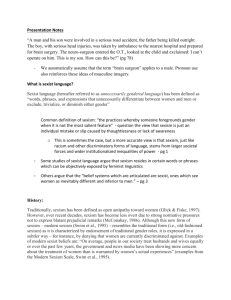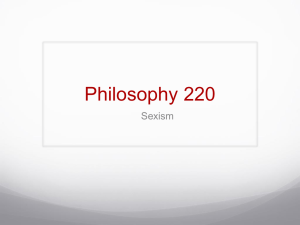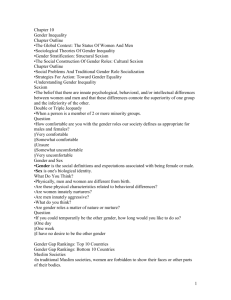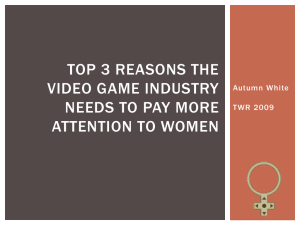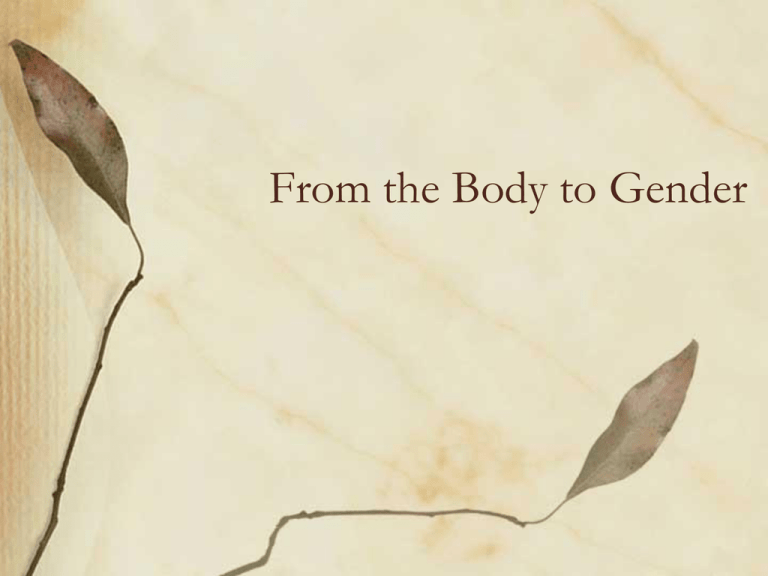
From the Body to Gender
Videos
• Killing Us Softly
• Bro Code
Videos
• Killing Us Softly
– Women are routinely objectified in our culture
• Valued for their appearance over other traits
• Sexualized
• Turned into objects
• Bro Code
– Contemporary culture promotes sexist men by:
•
•
•
•
Training men to objectify (or womanize)
Immerse men in porn
Make rape jokes
Obey the masculinity police
Videos
• Killing Us Softly
– Women are routinely objectified in our culture
• Valued for their appearance over other traits
• Sexualized
• Turned into objects
• Bro Code
– Contemporary culture promotes sexist men by:
•
•
•
•
Training men to objectify (or womanize)
Immerse men in porn
Make rape jokes
Obey the masculinity police
The role of the media
• Product and Producer
• Unrealistic images of beauty for men and
women
• Underrepresentation of women of color
• Overrepresentation of women as “parts”
Unrealistic Body Images
• The ideal female body is unattainable,
unrealistic, and dangerous
• Men are coming under increased pressure
to obtain muscular, lean ideals (25 years)
• Naked male image is more frequent in the
last decade
• Still, this new emphasis on male image is
not equivalent to women’s.
Images of Women of Color
(Baker, 2005; Coltrane & Messaneo, 2000)
• Tokenism
• Under Representation Bias
– Under 10% of mainstream TV ads include people
of color
• Subtle Racism
– Inconsequential
– Subservient to White
• Sexual images
Women as “Parts”
• Pervasive tendency to depict women’s
bodies more than their faces
• Faceism = index of facial prominence
• Lowest Faceism Index: Black Women
Self-Objectification
• Living in a culture that sexually objectified
women more than men
• Women learn to view themselves as objects
• Objectification = tendency to regard one’s physical
self primarily in terms of appearance and to adopt an
observer’s perspective on the physical self
Self-Objectification Questionnaire
•
•
•
•
•
•
•
•
•
•
•
NSTRUCTIONS: We are interested in how people think about their
bodies. The questions below identify 10 different attributes. We would
like you to rank order these body attributes from that which has the
greatest impact on your physical self-concept, to that which has the least
impact on your physical self-concept.
NOTE: It does not matter how you describe yourself in terms of each
attribute. For example, fitness level can have a great impact on your
physical self-concept regardless of whether you consider yourself to be
physically fit, not physically fit, or any level in between.
Please first read over all of the attributes. Then, record your rank by
writing the letter of the attribute.
WHEN CONSIDERING YOUR PHYSICAL SELF-CONCEPT, HOW
IMPORTANT IS…
9 = most important and 0 = least important
a. physical coordination?
f. physical attractiveness?
b. health?
g. energy level (e.g. stamina)?
c. weight?
h. firm/sculpted muscles?
d. strength?
i. physical fitness level?
e. sex appeal?
j. measurements
SO Score
• Sum of appearance related traits
• Sum of competence related traits
• Subtract competence from appearance
related traits
• Higher numbers = Greater objectification
States of Objectification
• Cover Story: Consumer Product
Evaluation
• Two conditions:
• Women and men asked to try on speedo
swimsuit or sweater
• DV: Level of objectification, shame and
math performance
• Measure of SO
• How many cookies they ate
Swimsuit v. Sweater: Self-Esteem
Swimsuit v. Sweater: Body
Concerns
Swimsuit v. Sweater: Body Shame
Swimsuit v. Sweater: Math
Performance
Effect of the Swimsuit
(shorts/swimsuits v. sweater)
That swimsuit becomes you
• Both men and women in speedos (of
various ethnicities) showed:
Gender Differences
• Main effect for gender:
– Women always rated themselves higher on
body shame and self-objectification.
• Different methodologies:
Fig. 1. Talking time as a function of participant’s gender, partner’s gender, and
communication condition.
Saguy T et al. Psychological Science 2010;21:178-182
Copyright © by Association for Psychological Science
Fig. 2. Percentages of women and men who chose each communication condition as their
least preferred one.
Saguy T et al. Psychological Science 2010;21:178-182
Copyright © by Association for Psychological Science
Physiological Disconnect
• Insensitivity to body sensation
• Women are less accurate in estimating
their heartbeat, blood glucose levels, and
stomach contractions than are men.
• Women’s subjective experience of arousal
correlated to a lesser degree with their
physiological sexual arousal than men.
Measuring Up-Where does shame come
from?(Fallon & Rozin, 1985)
• Ratings of their current size, the
ideal, what they think is
attractive to opposite sex
• Women thought they were
heavier than the their perceptions
of men’s ideal
• Men actually prefer heavier
women than women believe
– Men thought they were about
the same as ideal
• Women actually prefer smaller
than men think
• What are the implications?
Why do we care about appearance?
• Appearance is often paired with
ROMANCE and RELATIONSHIP
SUCCESS
• Women hear that men value appearance
over all else!
Testing the link
• Exposed men and women to relationship
primes or neutral primes
• Relationship primes: marriage, romance,
relationship, partner
• Neutral primes: door, house, gate, brick
• Measured SO
Romance Primes SelfObjectification Among Single
Women
Basing SE in Relationships
• Contingencies of self-worth
• The extent to which SE is connected to
relationship status
• For Men and Women Alike
GENDER
Gender
• We are hardwired to notice sex
– Single most remembered characteristic
• This may lead us to assume many sex
differences.
• However, men and women are more alike
than they are different
• Differences between men and women are
smaller than intragroup differences
How big are gender differences?
• .80 = LARGE DIFFERENCE
• .50 = MODERATE DIFFERENCE
• .20 = SMALL DIFFERENCE
ON SIMILARITIES (Hyde,
2005)
Bem’s Typology
• Sex (biological) v. Gender (social)
• In 1970s, Sandra Bem argued that people
were not necessarily sex = gender
• Instead, masculine, feminine, a mix of
both, or neither
– Androgynous
– Undifferentiated
• Psychologically gendered on a continuum
1970’s research
• Men and women fell into sex-typed
quandrants
• She found relatively few androgynous
people
• How did she measure it?
• Predetermined list of attributes known to
be gender-stereotyped!
Bem Sex Role Inventory
•
•
•
•
•
•
•
•
Confident
Leadership
Athletic
Opinionated
Decisive
Risk Taking
Aggressive
Masculine
•
•
•
•
•
•
•
•
Compassionate
Likes Children
Agreeable
Cheerful
Nurturing
Modest
Gullible
Feminine
Contemporary Research
• Given no other choice, men and women
sex typed themselves
• Better idea is to let people report the
attributes they identify with.
• Then, men and women report the same,
positive traits
Evolution of Gender Roles
• Assertiveness (Twenge, 2001)
– Sociocultural
– Meta-Analysis
• Social Status
– Education/Work Opportunities
Women’s Assertiveness
(Twenge, 2001)
Degrees Awarded to Women
Median Age of Marriage
Social Role Theory (Eagly, 1987)
• Origin of sex differences
• Differences evolve from societal roles
• Divisions of labor create gender-role
expectations
• Socialization Reinforcements
World War II
Sex differences in emotion?
• Women are believed to be more
emotionally expressive than men
• They are expected to emote more, to
show more sadness, fear, and guilt.
• There is only one emotion men are
expected to show more! Can you guess?
Is this true?
• The evidence for stereotyped beliefs is
strong, but not necessarily accurate
• Jussim asked people about stereotyped
beliefs
• Both men and women believed women
were more open emotionally expressive
but few, if any, reported differences.
Why do we believe these
differences exist?
•
•
•
•
Gender norms and expectations
Feeling does not mean expressing
We often don’t see gender role reversals
Believing in gender ideals and following
rules often reduces autonomy (Sanchez et al., 2005;
Sanchez et al., 2006)
Gender Norm Violations
• Backlash =
• Consequences fear of backlash?
Fear of Backlash for Women
• Harsh sanctions for gender role violators
• Competence v. Likable
– Women who self-promote are seen as more
competence but less hireable and less socially
attractive
Backlash
• Creates a vicious cycle of gender
stereotyping
• Double bind
Backlash as Identity Misclassification
and the Masculinity Police
• Fear of Identity Misclassification
– Being perceived as a social identity that you
are not
Study
• All heterosexual men
• Engaged in feminine/masculine task
• Confirm heterosexuality v. No
confirmation
• Public v. Private
Bosson et al. (2005)
Precarious Manhood
(Bosson & Vandello, 2011)
• Masculinity is something you need to
earn, and it is difficult to do so it is:
• How do you earn it?
Fig. 1. Percentages of physical reasons (e.g., “Grew weak with age”) and social reasons (e.g.,
“Behaved badly”) that people generated to explain either how a man might lose his manhood
or how a woman might lose her womanhood.
Copyright © by Association for Psychological Science Bosson
J K , and Vandello J A Current Directions in
Psychological Science 2011;20:82-86
Fig. 2. Percentages of stems completed as aggressive words (e.g., fight vs. right; punch vs.
lunch) by men and women who received feedback that either threatened or boosted their
gender status.
Bosson J K , and Vandello J A Current Directions in
Psychological Science 2011;20:82-86
Copyright © by Association for Psychological Science
Sexism: Ambivalence and
Double Standards
• Blatant displays of sexism are less socially
acceptable than in the past
– But do continue to persist today
• Gender stereotypes are distinct in that
they are not only descriptive, but also
prescriptive
– They tell people what they should do or be
Sex Discrimination
• Seems to have diminished over time, but
discrimination based on sex is still
prevalent today
Women in Specific Occupations
Ambivalent Sexism
• Form of sexism characterized by attitudes
about women that reflect both negative,
resentful beliefs/feelings as well as
affectionate and chivalrous but potentially
patronizing beliefs/feelings
– Hostile sexism
– Benevolent sexism
Ambivalent Sexism
(Glick & Fiske)
• Consists of two elements:
– Hostile sexism, characterized by negative, resentful
feelings about women’s abilities, values and ability to
challenge men’s power.
– Benevolent sexism, characterized by affectionate,
chivalrous, but potentially patronizing feelings of women
needing and deserving protection.
60
People Typically Don’t Recognize
• Exposure to BS (or Other Forms of
Complimentary Stereotypes) Increases
Support for Status Quo (Jost& Kay, 2003)
What is the Danger in Benevolent
Sexism (BS)?
• Aside from being relatively undetectable and making
people believe that status quo is fine……
• Victims of BS tend to perform worse on competence
tasks (Dardenne et al., 2007)

